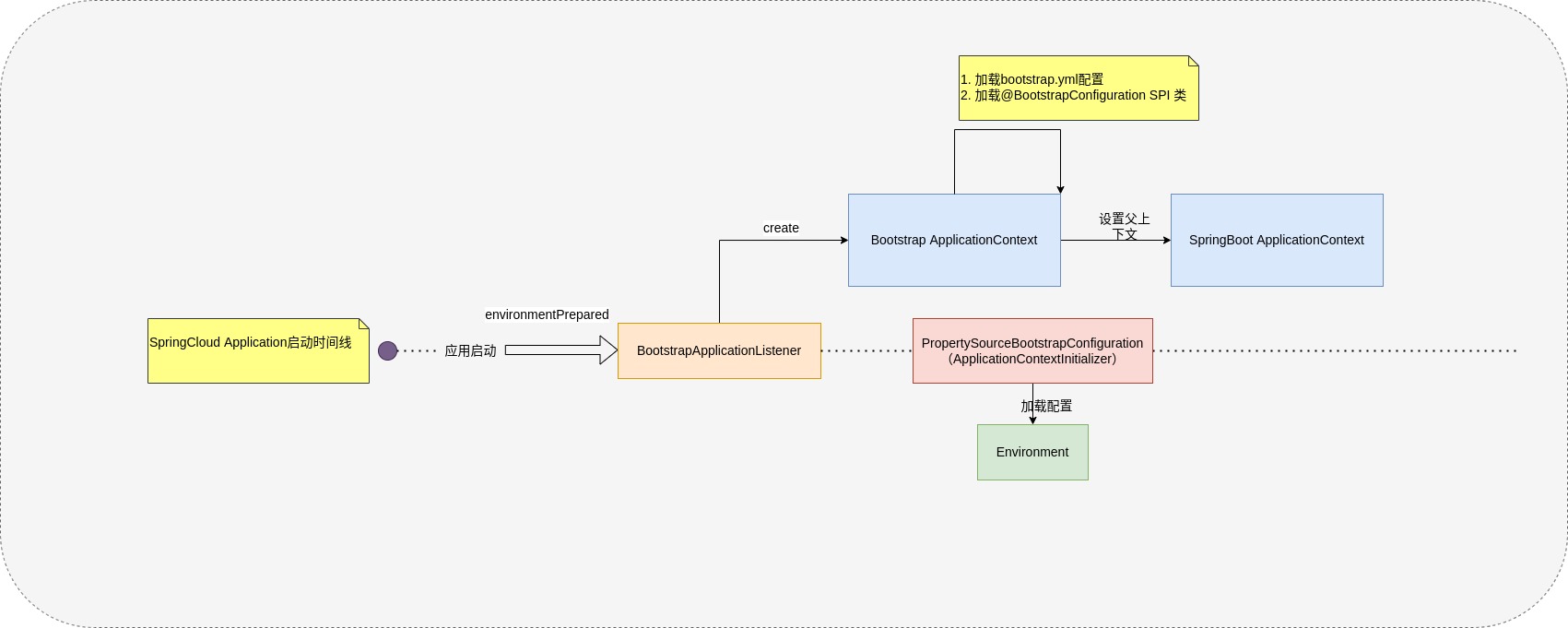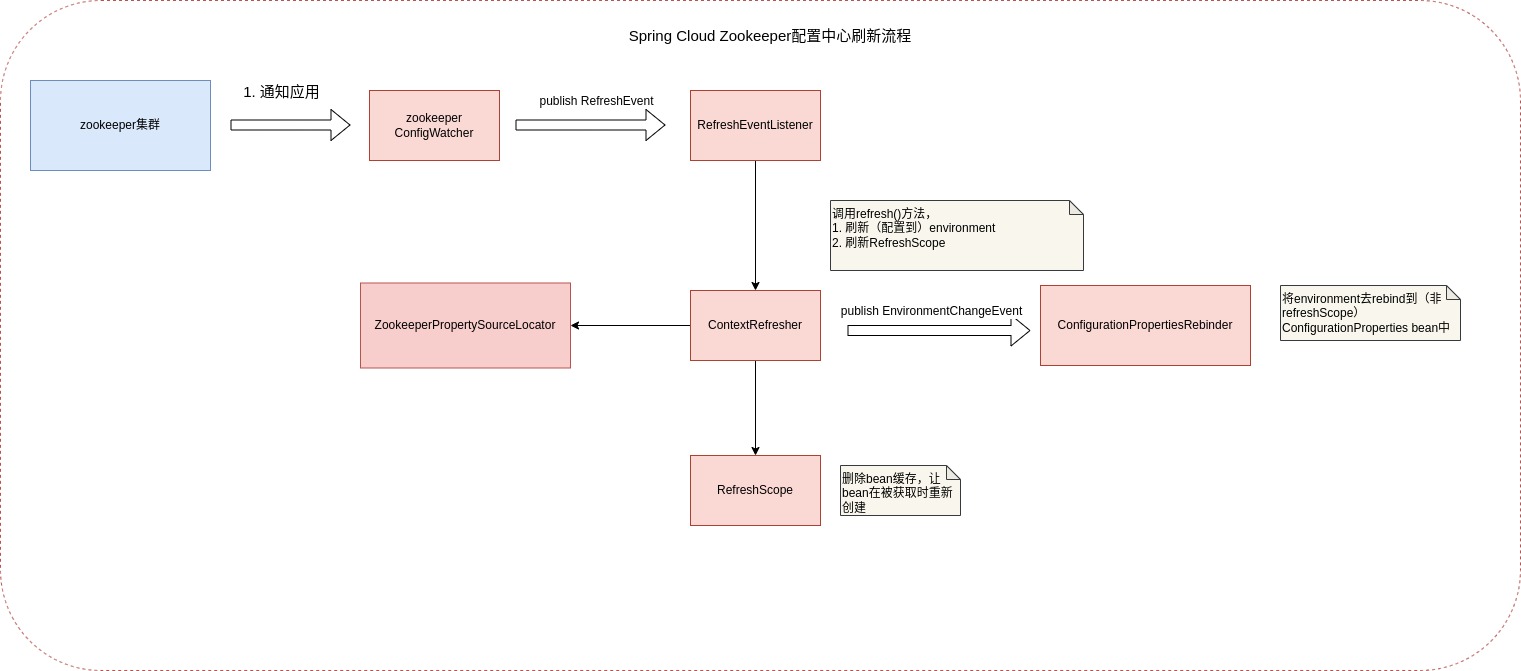Spring Cloud远程配置中心--Spring Cloud Context、Spring Cloud Zookeeper Config的实现分析
简介
Spring Cloud Context是Spring Cloud应用上下文的实现。
谈到Spring Cloud应用如何加载和刷新远程配置,就绕不开分析Spring Cloud Context(上下文)的启动和刷新, 而分析Spring Cloud Context的源码,又会有大量的篇幅是分析源码中大量加载配置,处理environment的部分。 所以我将Spring Cloud应用上下文的启动合并到这里分析。
Spring Cloud Context的一些组件,在这里先简单说说他们的作用:
- BootstrapApplicationListener
- PropertySourceBootstrapConfiguration
- PropertySourceLocator
- RefreshEventListener
- ContextRefresher
- RefreshEvent
- RefreshScope
- @RefreshScope
Spring Cloud Context启动
Spring Cloud Context初始化是跟随Spring Boot启动,首先会初始化类BootstrapApplicationListener。
BootstrapApplicationListener的执行时机是,应用初始化时接受到EnvironmentParented事件后。
@Override
public void onApplicationEvent(ApplicationEnvironmentPreparedEvent event) {
//获取environment,注意此时application.yml尚未加载,BootstrapApplicationListener的order高于ConfigFileApplicationListener。
ConfigurableEnvironment environment = event.getEnvironment();
if (!environment.getProperty("spring.cloud.bootstrap.enabled", Boolean.class,
true)) {
return;
}
// 已经加载了bootstrap配置的话,则跳过
if (environment.getPropertySources().contains(BOOTSTRAP_PROPERTY_SOURCE_NAME)) {
return;
}
ConfigurableApplicationContext context = null;
//配置文件名默认bootstrap(.yml/.properties)
String configName = environment
.resolvePlaceholders("${spring.cloud.bootstrap.name:bootstrap}");
//查找当前应用是否已通过ParentContextApplicationContextInitializer去存储了parent。
for (ApplicationContextInitializer<?> initializer : event.getSpringApplication()
.getInitializers()) {
if (initializer instanceof ParentContextApplicationContextInitializer) {
context = findBootstrapContext(
(ParentContextApplicationContextInitializer) initializer,
configName);
}
}
if (context == null) {
//1. 设置相关cloud配置属性, 比如spring.config.name=bootstrap
//2. 启动一个WebApplicationType=NONE的SpringApplication应用,用于加载bootstrap(.yml/.properties)
//3. 加载BootstrapConfiguration配置类
//4. 将加载的应用上下文作为父上下文
context = bootstrapServiceContext(environment, event.getSpringApplication(),
configName);
//加上CloseContextOnFailureApplicationListener,通过监听器在Context关闭时,关闭父context
event.getSpringApplication().addListeners(new CloseContextOnFailureApplicationListener(context));
}
// 将cloud context的ApplicationContextInitializer加到子应用中
// 添加配置解密初始化器
apply(context, event.getSpringApplication(), environment);
}
加载远程配置的加载器--PropertySourceLocator和PropertySourceBootstrapConfiguration
PropertySourceLocator是Spring Cloud Context加载或拉取配置的一个配置加载器。
在应用启动和刷新时,PropertySourceBootstrapConfiguration通过调用PropertySourceLocator去加载配置到environment。
下面,我们来看看重点方法的分析:
@Override
public void initialize(ConfigurableApplicationContext applicationContext) {
//创建Spring Cloud的CompositePropertySource
CompositePropertySource composite = new CompositePropertySource(
BOOTSTRAP_PROPERTY_SOURCE_NAME);
AnnotationAwareOrderComparator.sort(this.propertySourceLocators);
boolean empty = true;
ConfigurableEnvironment environment = applicationContext.getEnvironment();
//遍历PropertySourceLocator,并找出PropertySource
for (PropertySourceLocator locator : this.propertySourceLocators) {
PropertySource<?> source = null;
source = locator.locate(environment);
if (source == null) {
continue;
}
logger.info("Located property source: " + source);
composite.addPropertySource(source);
empty = false;
}
//如果PropertySourceLocator成功加载了相关配置
//1. 删除原bootstrap配置
//2. 更新LoggingSystem,更改logLevel
//3. 对active的profile做更新
if (!empty) {
MutablePropertySources propertySources = environment.getPropertySources();
String logConfig = environment.resolvePlaceholders("${logging.config:}");
LogFile logFile = LogFile.get(environment);
if (propertySources.contains(BOOTSTRAP_PROPERTY_SOURCE_NAME)) {
propertySources.remove(BOOTSTRAP_PROPERTY_SOURCE_NAME);
}
insertPropertySources(propertySources, composite);
reinitializeLoggingSystem(environment, logConfig, logFile);
setLogLevels(applicationContext, environment);
handleIncludedProfiles(environment);
}
}
总结
以上,笔者分析了Spring Cloud Context的启动过程。刷新配置的过程是通过ContextRefresher然后进行类似的应用上下文刷新去做的, 不在上面描述了。
下面通过启动流程图和刷新流程图来做一个总结。
Spring Cloud Context启动流程

配置刷新流程--以Spring Cloud Zookeeper Config为例
